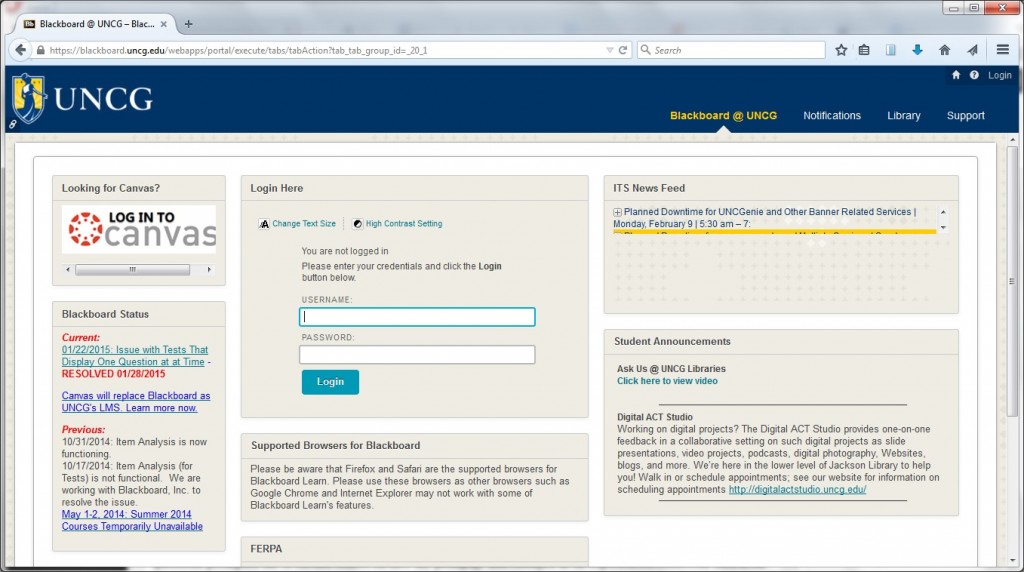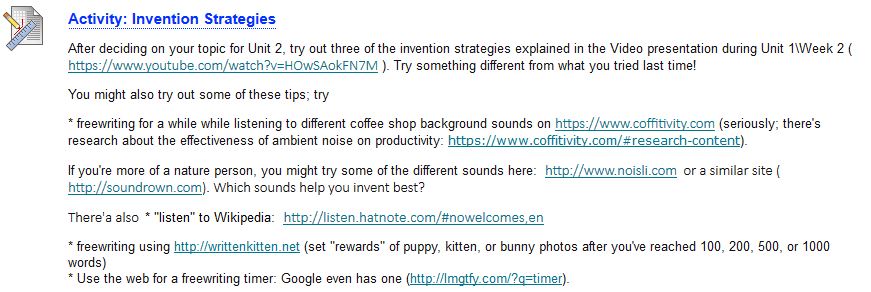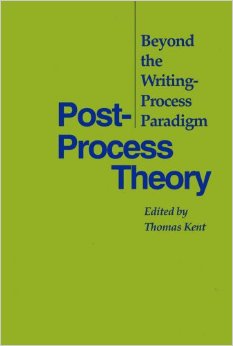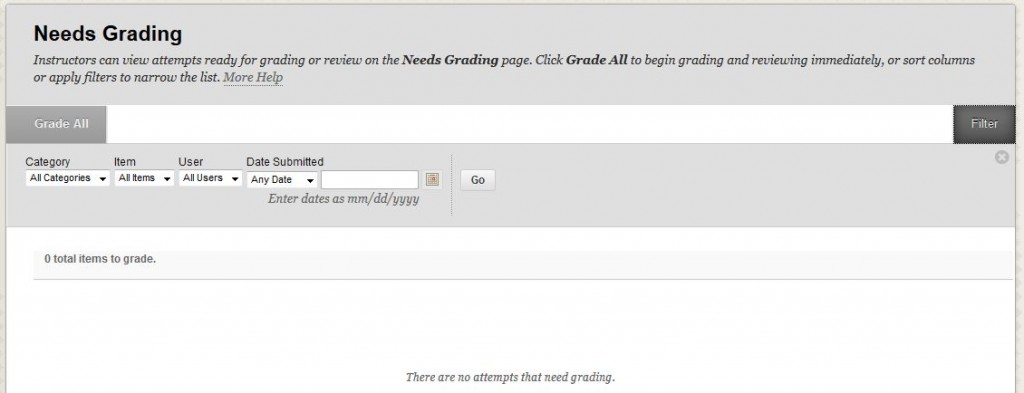Welcome back to this week’s Reflections from the Trenches in the Cloud, a series about online writing instruction.
In the TA program where I work, new TAs observe more experienced instructors as an opportunity to learn about teaching in general and in the program. This fall, when new TAs asked to observe me in my online course, I unexpectedly had to stop and think about the observation process of an online course. Confirming an online observation wasn’t as simple as saying, “Come to room 1205 at 9 AM Friday and we’ll talk after class about what you saw.” Did I show them the course videos I had developed? The tools to create those videos? The discussion board posts, which are something I use in both face-to-face courses as well as online ones? The comments I gave students on their assignments? The emails I exchanged with students?

While I’ve already written some about how the where and when of teaching online changes, this week I’d like to consider some of the ways pedagogy may change in the asynchronous online writing class. The new TAs who observed my online teaching asked interesting questions about pedagogical approaches, starting with the very interesting, “Where do the teaching moments occur?” and “What pedagogy do you use in the online class and is it the same as the one in your face-to-face classes?”
In Teaching Writing Online, Scott Warnock suggests that migration of an instructor’s classroom teaching practices can serve as a helpful strategy for developing an online pedagogy. He identifies common classroom practices: Talking to or lecturing students; asking Socratic questions; engaging in conversations with students; having students work in groups; engaging students in workshop activities; asking students to engage in unsupervised work (28-29). He suggests that these activities can be migrated to the online course. First, however, teachers should engage in reflection to consider what they already like to do in the classroom and how they like to teach (35).
The Process of Online Pedagogy
While I had already applied Warnock’s recommendations in the course development process, the observing TAs’ questions prompted me to further reflect on how my pedagogy had changed as an experienced classroom instructor who had transitioned to teaching online. I had, as Warnock suggested, migrated activities from the classroom, but I had also evolved my pedagogy for the online course. Teaching in a program that values drafting, peer review, and revision, I developed activities for those in my online classes, and in doing so, continued to support a process theory-friendly pedagogy.

Lad Tobin describes some of characteristics of process pedagogy from the late 1970s and the early 1980s as focusing on “student choice of topics and forms; the necessity of authentic voice; writing as a messy, organic, recursive form of discovery, growth, and personal expression” (4). While we’re a number of years past that period, aspects of process pedagogy survive. Tobin writes, “Process pedagogues are still apt to devote most class time to responses to students works-in-progress; to discussions of ‘the process’ (that is, to the methods that successful writers use to find and focus topics, to discover their meaning and voice, to productively give and take peer review); and to writing exercises. They are likely to emphasize invention strategies, the necessity of revision after feedback; and reading assignments designed to support the students as writers” (16).

Letting Go of Process Pedagogy with Post-Process Theory
Post-process theory has, however, critiqued process theory as being too focused on a singular, universal process or trying to create a singular, generalizable knowledge that can teach writing. Thus, post-process theorists developed an alternative approach that Thomas Kent identifies as focusing on writing as
(1) public, meaning that writing is a communicative interaction between language users and the writer; in other words, “We are never alone; we write always in a relation with others”;
(2) interpretive, a broad concept meaning “something like ‘making sense of'” and applied to both the reception and the production of discourse; and
(3) situated, an aggregative understanding that “communication—and, therefore, writing—cannot begin nowhere. Because writing is a public act that requires interpretative interaction with others, writers always write from some position or some place; writers are never nowhere” (1-3).
Lee-Ann M. Kastman Breuch suggests that the theory “signifies a rejection of generally formulaic frameworks for explaining writing” but “rather than the rejection of process, the post-process critique contributes to our discipline through the rejection of mastery—the description of writing as a ‘thing,’” a move which Joseph Petraglia describes as a “letting go” (132-133). “Letting go,” Breuch argues, “does not mean an avoidance of the teaching of writing” (146). Instead, post-process theory rejects “pedagogical agendas that are comprised of content”; that said, the theory offers “valuable pedagogical principles about the activity of teaching” (139). Breuch argues that “the strongest application of post-process theory is in the practice of one-to-one instruction that manifests itself in teacher-student interactions” (143). She advocates a mentoring model, much like that theorized by writing center pedagogy.
A Process-Oriented Post-Process Pedagogy
In developing my online writing course, I migrated over face-to-face classroom activities as Warnock suggested, such as talking to students or lecturing by creating videos or delivering limited content through documents posted to our LMS. I asked questions and engaged in conversations with students by creating discussion boards. I continue to support students’ development of their writing processes through their submission of writing activities.
I recognize, however, that doesn’t mean that my online pedagogy is identical to my in-person classroom’s approach. In a face-to-face class, I can quickly monitor my students comprehension by glancing at their faces; I can walk around and talk to groups and provide on-the-spot feedback.
Online, I still incorporate support for the process work valued in our program. While I can’t provide the same type of group feedback I can in a face-to-face class, I do provide individualized feedback–lots of it.

As online students submit multiple bits of writing work as they proceed toward the development of their culminating projects, I provide one-on-one feedback, asking questions to guide their drafting and revision, as well as by providing reader responses, indicating where I find their writing particularly compelling and persuasive or where I’ve gotten lost. This level of feedback results from my teaching in an online class capped at 20 in accordance with the CCCC Effective Practices for Online Writing Instruction (OWI) Principle 9. This online class environment supports the sort of one-to-one writing instruction that Breuch suggests is an application of post-process pedagogy.
Composition pedagogies, whether individual or disciplinary, evolve. Further, I believe that our pedagogies, again whether individual or disciplinary, are multiple. As we engage in more online and hybrid instruction, our composition pedagogy theories will continue to evolve—both for the electronic environment and with impacts to our face-to-face classroom instruction.
Share with us in Comments how your writing pedagogy–whether for online or face-to-face–has changed from teaching online.
Works Cited
- Breuch, Lee-Ann M. Kastman. “Post-Process ‘Pedagogy’: A Philosophical Exercise.” JAC 22.1 (2002): 119-150.
- Kent, Thomas. Post-Process Theory: Beyond the Writing-Process Paradigm. Carbondale, Ill: Southern Illinois University Press, 1999.
- Tobin, Lad. “Process Pedagogy.” A Guide to Composition Pedagogies. Eds. Gary Tate, Taggart A. Rupiper, and Kurt Schick. New York: Oxford University Press, 2001. Print. 1-18.
- Warnock, Scott. Teaching Writing Online: Why and How. Urbana, IL: NCTE, 2009.
